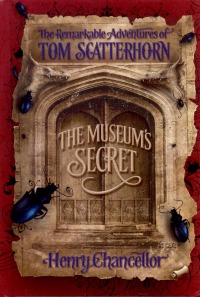| ________________
CM . . .
. Volume XV Number 14. . . .March 6, 2009 
 |
The Museum's Secret. (The Remarkable Adventures of Tom Scatterhorn).
Henry Chancellor.
Toronto, ON: Doubleday Canada, 2008.
455 pp., hardcover, $19.99.
ISBN 978-0-385-66522-3.
Grades 6-9 / Ages 11-14.
Review by Todd Kyle.
1/2 / 4
|
| |
|

excerpt:
So it was real: he hadn't dreamt it up! Floor polish and hyacinths, that was it...that smell.... August had no idea that his concoction -whatever it was- was far stronger than any of his other chemical mixtures. It had outlasted them all. And could it be that this potion had also made the animal conscious? Had it given life to their brains, which were stuffed with old newspapers and cuttings from the Bible? Was this the reason why they could think, and even speak? Tom's eyes widened as he stared down at the small blue bottle on the workbench. If it was, August had accidentally discovered something so powerful it was almost too big to comprehend. And he didn't even know it.
The father of 12-year-old Tom Scatterhorn disappears while researching beetles in Mongolia, and Tom is left in the care of his aunt and uncle, proprietors of the Scatterhorn Museum, a collection of animals hunted a century ago by Sir Henry Scatterhorn and taxidermied by his friend, August Catcher. Tom discovers that the animals are apparently alive and that he can travel back in time to August and Henry's era, eventually discovering that the potion August invented that keeps the animals alive will be used by giant beetles in the future to take over the world unless he and his fellow time-travellers - and his parents - can stop them.
The Museum's Secret is a book full of convoluted plot twists, meaningless details, baffling dialogue, and inconsistent narration that strains to its breaking point the credibility of what is at its base a very intriguing concept: the accidental invention of a potion that can bring the dead back to life. But instead of a morality play, or a fun and ironic romp, this 450-plus-page tome is mostly bombast that misses the mark entirely. Even when it could be emotive, it is melodramatic; even when it could be funny, it is simply too earnest for its own good. Compared with the vast array of quality fantasy that evokes human truths while it takes readers on incredible journeys, this is poor fare indeed.
The most obvious flaw is the narration, which seems at first to be third-person limited point of view; that is, we know only what Tom knows, even though he is not the narrator. This is what the reader would expect from a time-travel novel where the main character cannot know anything of what is going on around him when he travels to another time. But inexplicably, the narrator randomly shows us trivial observations of characters, even while keeping the plots they are hatching a secret. So when Tom meets the mysterious Don Gervase Askary-a villainous time-traveller-in the past, the narrator quips that Don was sure he'd seen Tom somewhere before but can't be sure where; at the same time, neither we nor Tom know that Askary is seeking the magic potion!
The sloppy editing does not end there, however. The book is largely set in Dragonport, a seaside town with regular snow and a frozen river-except that it is apparently in England, whose climate is too warm for that. When Tom first travels in time, trying to avoid the police, he returns to the present at the same moment, with the police leaving, unable to find him. The second time he travels, he is avoiding the prowling tiger in the museum, but when he returns, he simply goes to bed, and there is no mention of the deadly animal! And the sequence that takes place in India - where Henry and August are hunting the very same tiger - is so poorly drawn that there is almost a whiff of cultural insensitivity - with names like the Maharajah of Champawander and a journalist named Mungo Natterjee.
All of these twists and turns and details do eventually bring the book to a conclusion, except that although all is well with the now-restored and orderly museum, there is a blithe reference to the fact that the beetles still remain to be defeated-the subject of the next book in the series, one supposes. But despite its outward appeal, this adventure is too confusing, too inconsistent, and frankly too boring to entice most young people to read the next installment.
Not recommended.
Todd Kyle is a former President of the Canadian Association of Children's Librarians who is currently a library branch manager in Mississauga, ON.

To comment
on this title or this review, send mail to cm@umanitoba.ca.
Copyright © the Manitoba Library Association. Reproduction for personal
use is permitted only if this copyright notice is maintained. Any
other reproduction is prohibited without permission.
NEXT REVIEW |
TABLE OF CONTENTS FOR THIS ISSUE
- March 6, 2009.
AUTHORS |
TITLES |
MEDIA REVIEWS |
PROFILES |
BACK ISSUES |
SEARCH |
CMARCHIVE |
HOME |
